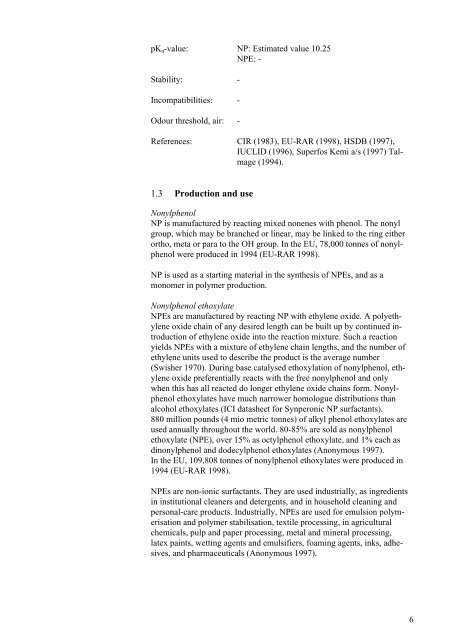Toxicological Evaluation and Limit Values for ... - Miljøstyrelsen
Toxicological Evaluation and Limit Values for ... - Miljøstyrelsen
Toxicological Evaluation and Limit Values for ... - Miljøstyrelsen
- No tags were found...
You also want an ePaper? Increase the reach of your titles
YUMPU automatically turns print PDFs into web optimized ePapers that Google loves.
pK a -value: NP: Estimated value 10.25NPE: -Stability: -Incompatibilities: -Odour threshold, air: -References: CIR (1983), EU-RAR (1998), HSDB (1997),IUCLID (1996), Superfos Kemi a/s (1997) Talmage(1994).1.3 Production <strong>and</strong> useNonylphenolNP is manufactured by reacting mixed nonenes with phenol. The nonylgroup, which may be branched or linear, may be linked to the ring eitherortho, meta or para to the OH group. In the EU, 78,000 tonnes of nonylphenolwere produced in 1994 (EU-RAR 1998).NP is used as a starting material in the synthesis of NPEs, <strong>and</strong> as amonomer in polymer production.Nonylphenol ethoxylateNPEs are manufactured by reacting NP with ethylene oxide. A polyethyleneoxide chain of any desired length can be built up by continued introductionof ethylene oxide into the reaction mixture. Such a reactionyields NPEs with a mixture of ethylene chain lengths, <strong>and</strong> the number ofethylene units used to describe the product is the average number(Swisher 1970). During base catalysed ethoxylation of nonylphenol, ethyleneoxide preferentially reacts with the free nonylphenol <strong>and</strong> onlywhen this has all reacted do longer ethylene oxide chains <strong>for</strong>m. Nonylphenolethoxylates have much narrower homologue distributions thanalcohol ethoxylates (ICI datasheet <strong>for</strong> Synperonic NP surfactants).880 million pounds (4 mio metric tonnes) of alkyl phenol ethoxylates areused annually throughout the world. 80-85% are sold as nonylphenolethoxylate (NPE), over 15% as octylphenol ethoxylate, <strong>and</strong> 1% each asdinonylphenol <strong>and</strong> dodecylphenol ethoxylates (Anonymous 1997).In the EU, 109,808 tonnes of nonylphenol ethoxylates were produced in1994 (EU-RAR 1998).NPEs are non-ionic surfactants. They are used industrially, as ingredientsin institutional cleaners <strong>and</strong> detergents, <strong>and</strong> in household cleaning <strong>and</strong>personal-care products. Industrially, NPEs are used <strong>for</strong> emulsion polymerisation<strong>and</strong> polymer stabilisation, textile processing, in agriculturalchemicals, pulp <strong>and</strong> paper processing, metal <strong>and</strong> mineral processing,latex paints, wetting agents <strong>and</strong> emulsifiers, foaming agents, inks, adhesives,<strong>and</strong> pharmaceuticals (Anonymous 1997).6
















